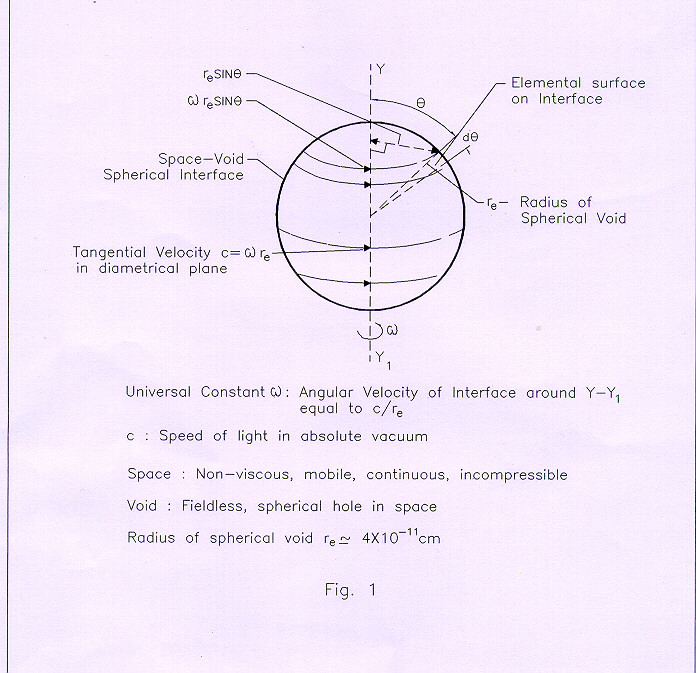
Light-Principle in Special Theory of Relativity
(Paramahamsa Tewari, B. Sc. Engg.)*
Introduction
With the discovery of positron (1932), a unique phenomenon of annihilation of matter (electron and positron) was observed. In this process, both the particles lose their mass, charge, and existence, producing annihilation-radiation, that is, light. An essential fact revealed through annihilation is that light is the last phenomenon of energy-effect before electron and positron lose their basic properties. Therefore, in order to understand the nature of light produced, an exact knowledge on the nature of charge and mass, and their distribution in the structure of the particles is essential, so as to gain deeper insight of the physical process of conversion of mass and charge into light, and to avoid any erroneous conclusion in the interpretation of this phenomenon. Further, light produced by thermal radiation is also considered emitted by orbital electrons in atoms, though, the structure of the electrons is not affected in this process. Light is some form of energy; and energy, from mass-energy equation, is expected to have proportionate mass. Therefore, understanding the origin of mass and charge in the electron structure is the first crucial step in determining the real nature of energy and the annihilation-light.
Apart from the basic properties of light, that is energy-content, wavelength and frequency, the process of its transmission in absolute vacuum is equally important. In post relativity era, space medium, when considered without electromagnetic fields, is believed an empty extension (void) and, yet, light is supposed to be somehow transmitted in this void of nothingness. Such an assumption presupposes that the properties of mass, inertia, charge, and energy, possessed by matter, are independent of spatial reality, that is, the energy constituting matter is not derived from space. But, a comprehensive theory that explains creation of mass, inertia, charge and energy, say, in electron-structure; and that pinpoints the very source of universal energy and its fundamental nature, is nonexistent in contemporary physics.
In this article, creation of electron from space, postulated to be fluid and nonmaterial in my earlier works [1,2,3] has been first described; mass, charge, energy and basic fields in the electron structure and the medium of space are briefly analyzed and defined; and from the observed conversion of mass and charge in the annihilation process, nature of the annihilation-light has been determined. With the new physical picture of the annihilation-light, shown here to be the most fundamental light-effect in the universe, conceptual errors in the current understanding of the nature of light have been pinpointed. Einstein's light-principle in special theory of relativity has been examined for its correctness.
Mass and Charge of Electron
The property of mass of electron has been shown [1,2,3]
to originate from the medium of space - postulated to be a nonmaterial
medium with fluidity, incompressibility, continuity, homogeneity, mass-less
ness, and zero-viscosity. That is, none of the properties, except fluidity,
possessed by matter, exists in space. The only property of the fluid-medium
of space (hereafter, referred as "space") is a limit to its velocity of
flow and also to the angular velocity of rotation (w
) when circulating in a vortex. Fig.1 shows an irrotational vortex of space
which has opened up at the center into a dynamically stable spherical void
due to the postulated limiting w , which is
also the maximum velocity gradient, c/re, where "c" is the limiting
flow of space (maximum velocity-field), and "re" is the radius
of the spherical interface enclosing the void.

A diametrical cross section of the vortex (Fig.2) shows
an inward maximum acceleration-field c2/re;
this inward radial acceleration of space prevents dilation of the vortex
and results in dynamic stability. The vortex described above is the electron
structure.
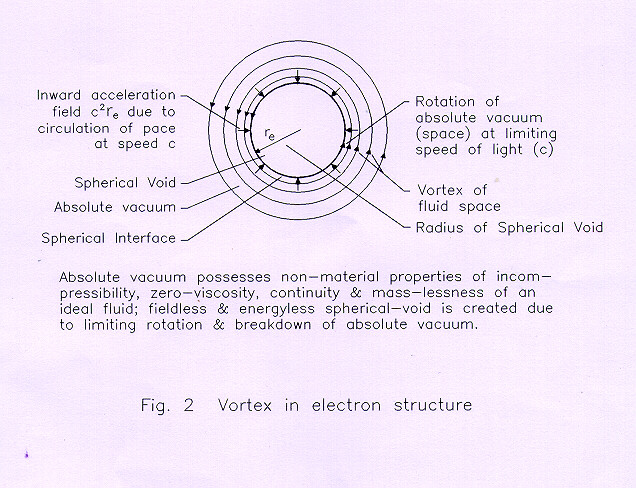
The mass of electron is defined as volume-integral of space-velocity within the interface, just prior to the creation of electron; and can be derived (Fig. 1) considering a differential element of volume: dV = (p re2 sin2 q ) re dq , since, space, equivalent to this volume, is forced out at velocity w re sin q during the creation of void when the speed of space in circulation reaches c, and angular velocity becomes w . Mass of the elemental volume from above definition: dM = dV (w re sin q ). Integral over the spherical volume within the interface gives, q varying from 0 to p
me = (4p /3) re3 c. (1)
Mass has the dimension of [L4/ T], and in CGS unit, it has been derived3:
gram = 8.6 x 106 cm4/s. (2)
Charge of electron is defined as the surface integral of space velocity on the spherical interface. Considering the elemental surface: dA= (2p re sinq ) re dq , and charge on it: dQ = [(2p re sin q ) re dq ] w re sin q . Integrating over the whole interface, q varying from 0 to p
qe = (p /4) 4p re2 c. (3)
The charge has the dimension of [L3/T], and in CGS unit,
CGSE = cm3 /s. (4)
With the use of (1), inward gravitational field (g) due to mass of electron at a radial distance r from the electron center has been derived1,2,3
g = (k/4p c) me / r2 (5)
where k is 1/s2.
With the use of (4), inward electric field (E) due to charge of electron at a radial distance r from the electron center has been derived1,2,3
E = -c2 re2 sin2 q / 2 r2. (6)
Basic constants derived [1,2,3] are: Coulomb's constant, with electron as the unit of charge, is c/4p ; dialectic constant of vacuum: Î = p / 2c; permeability-constant: m 0 = 2 / p c; electron's intrinsic angular momentum: L= (4/5) me c re; magnetic moment of electron: m = (3/4) qe c re; Planck constant1 for electron: h = (4/5) me c re. All these constants show proportionality to c, which quantitatively proves the postulated universality of c.
Energy in Electron Structure
Qualitatively, most basic state of universal energy is defined as "dynamic space in linear, accelerating, or circulating motion".
The central void at the electron center is field-less
and hence energy-less (Fig. 3a), whereas, as per the modern concept of
electron - a point-mass and a point-charge - energy is distributed all
the way up to the center (3b).
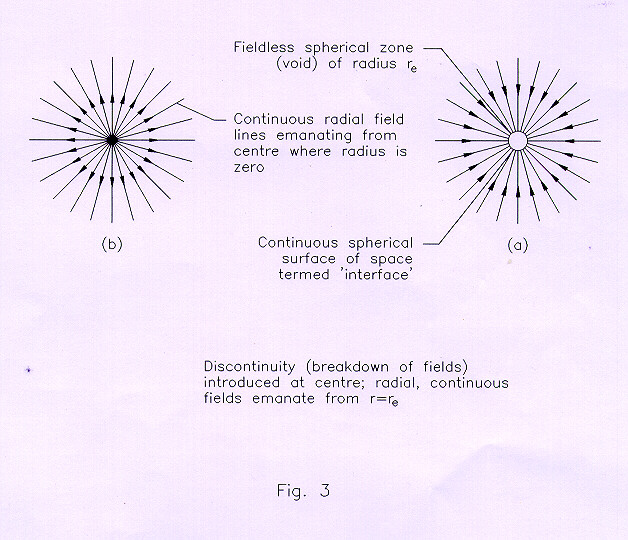
The latter leads to the following serious problems:
(a) energy in the electrostatic field of an electron becomes infinite at r = 0;
(b) electron can emit and absorb energy.
With the central void at the electron center, minimum value of r is re, and not 0; thus avoiding the integration of energy to reach an infinite value. Also, the energy-less center of electron cannot emit energy (photons); neither can it absorb energy, because, the interface of the electron with space-circulation at limiting speed, is impervious to all external interactions. The distribution of energy in the structure of a stationary electron starts from its interface and spreads throughout the universal space as gravity and electrostatic fields. During motion, acceleration, or rotation of electron around a center, relative to space, the gravitational and the electrostatic energy is seen [1,2,3] as electromagnetic energy or light (discussed later).
Energy of Electron Creation
Refer to Fig. 1. As explained earlier, a differential element of disc with volume: dV= p re2 sin2 q re dq , has mass: dM = dV (w re sinq ) = c p re3 sin3 q dq . The area at the interface of the elemental disc, 2p re sin q re dq , is subjected at each point to an inward radial acceleration field: af = (w re sin q ) 2 / re sinq = c2sin q / re, where c = w re. Supposing, the elemental disc collapses under the above inward acceleration-field to zero radius. The work done in this process will be:
dE = dM af (re sin q )
= (c p re3 sin3 q dq ) (c2 sin q / re) (re sinq ) = p re3 c3 sin5q dq .
Integrating over the whole interface where q varies from 0 to p
E = (4/5) [(4p /3) re3 c] c2,
which, from mass-equation (1), becomes
E = (4/5) me c2. (7)
The 'work done' is the energy produced due to the displacement of the inward acceleration field from the interface to its center; this energy fills up the void, and should be equal to the energy required to create the void at the electron center. Thus, the energy required for the creation of electron from (7) is (4/5) me c2.
Medium of Space, and its States
Fig. 4(a) shows the most basic state of space-a static non-viscous fluid, incompressible, continuous and mass less. This is the most basic substratum of the universe, existing eternally. In Fig. 4(b) dynamic space is depicted. The flow-velocity of space is termed as velocity-field-the most fundamental field, which produces all energy fields (Fig. 4c), that is, gravity, electrostatic, magnetic, nuclear, and electromagnetic. The solar system exists in the universal dynamic space with fields and matter (Fig. 4c) created by the galaxy.
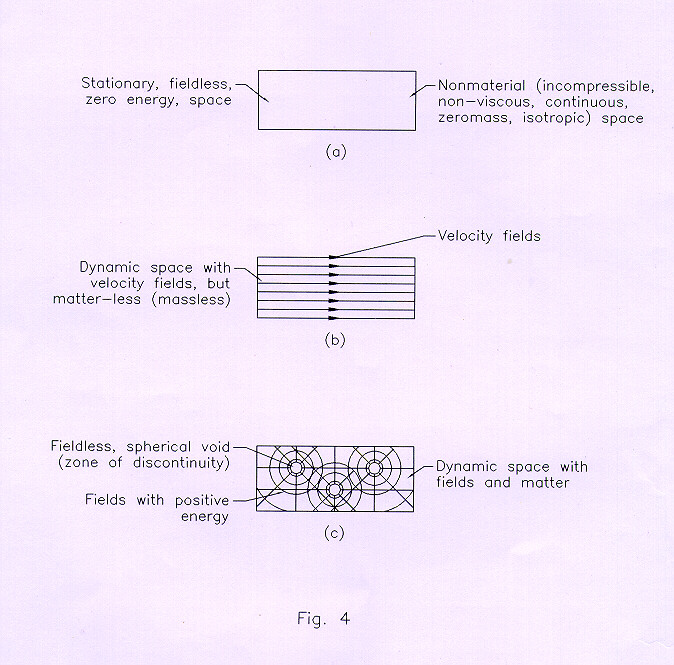
Creation of Electron
The process of creation2 of electron is shown
in Fig. 5.
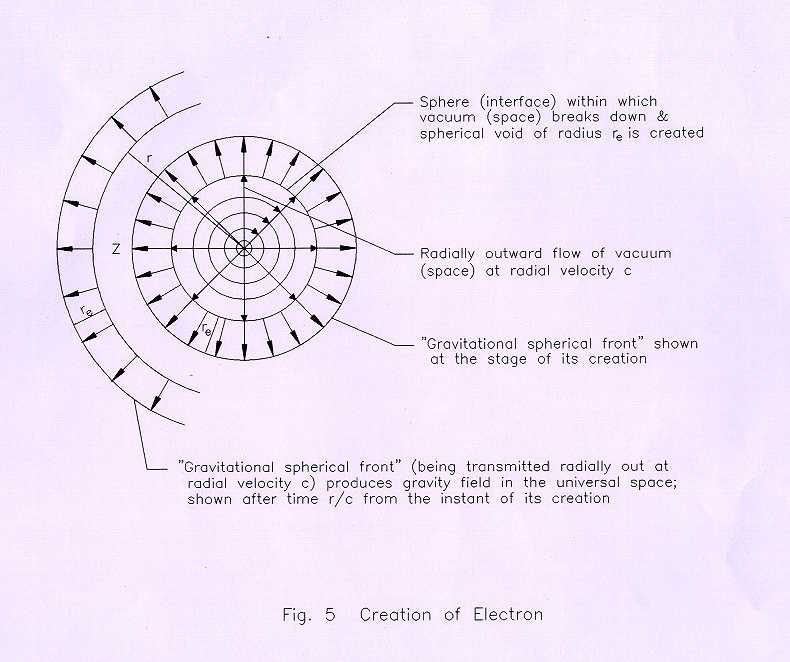
In a space vortex (irrotational) when the angular velocity
of rotation reaches the limiting w , space breaks
down into a spherical void due to being subject to the highest velocity
gradient c/re, as discussed before. The radial outward flow
of space, creating the interface, takes place at the limiting speed c,
and halted after a time interval re /c, because that is the
maximum volume of the spherical void possible for dynamical stability.
Since the fluid space is incompressible, a spherical shell of radial width
re, with outward pressure3 in it, is created concentric
with the interface (void), and is transmitted in the universal space at
the limiting speed c, thus energizing the universe gravitationally. Due
to the incompressibility of space, at a sphere of radius r, there will
be actual displacement (radial) of space points (Fig. 6), which will create
gravitational potential there proportionately. This potential will exist
as long as the void exists at the electron center.
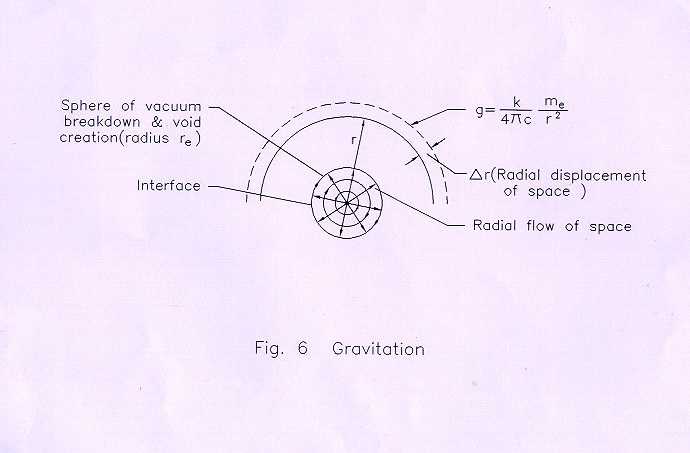
Annihilation Process
There can be two electron vortices, with their velocity
fields (in between them), opposite in direction, or in the same direction
(Fig. 7a,b).
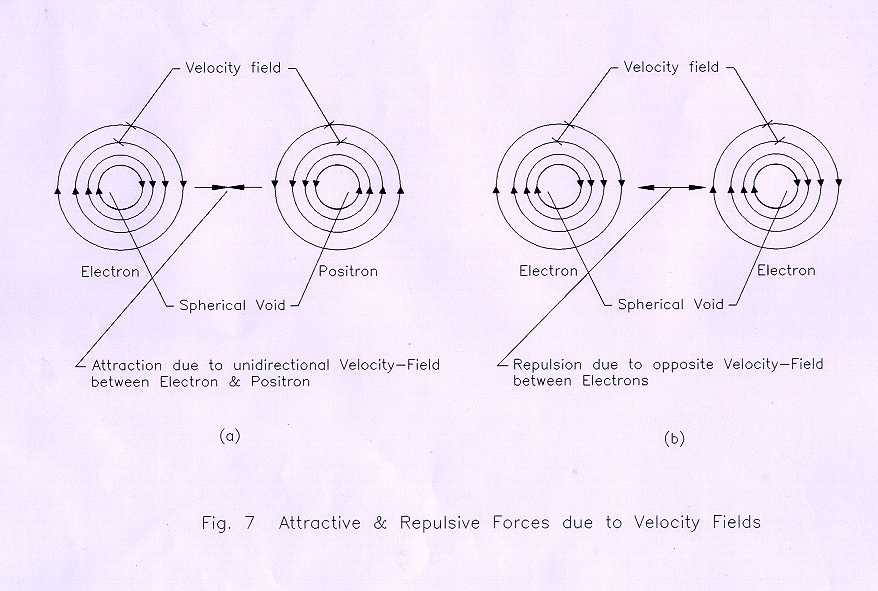
There is only one fundamental particle [1,2,3], electron, which, looked from the other end of its axis, is a positron. Positive and negative charges are relative concepts. Electrical attraction between an electron and a positron can be determined from (6) from which Coulomb's equation has been derived [1,2,3]. Qualitatively, the unidirectional velocity fields between an electron and a positron (Fig.7a) cause attractive electrical force drawing the particles together. In this process, the spherical interfaces of the particles can be imagined to finally superpose each other (Fig. 7c); thus stopping the oppositely directed space-circulations around their interfaces, and leading to the collapse of their central voids and annihilation of the particles. Consequently, as experimentally observed, light is produced.
Fundamental Nature of Light
It is evident that the void-interiors of
the electron and positron, being energy-less, cannot emit any kind
of energy (photon). The energy (velocity and acceleration fields) in the
vortex structure of these particles pervades the whole universal space
before annihilation; and following annihilation, the process of dying
(reducing to zero) of the electromagnetic and gravitational potentials
of the particles, initiating from their superposed interfaces, is seen
as a pulse, or a single shell of light (Fig.8).
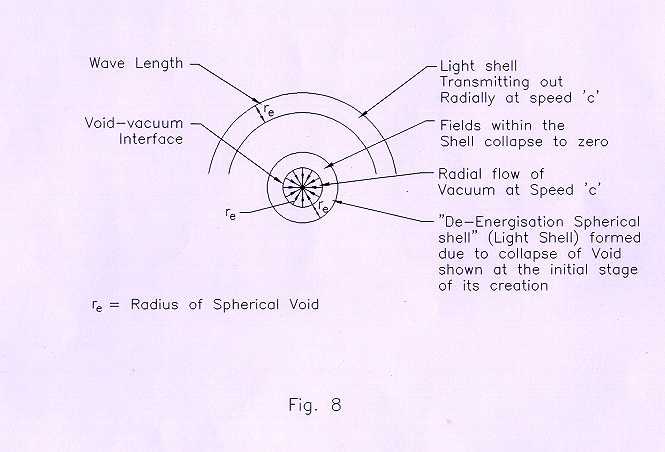
When the interfaces of the particles superpose, there is only one spherical-void common to both; space flows radially at its maximum speed c into the void (Fig. 8); the duration of collapse, D t = re / c. During this time interval, a shell of radial width, D t c, that is, (re/c) c = re, is formed, and transmitted outward at speed c relative to space. The transmission of the shell is a process that de-energizes the space medium, erasing for all the time the gravitational and electrostatic potentials that were created at the time of creation of the (now non existent) electron and positron. The spherical shell produced due to dying of potentials-a process of de-energizing of space substratum consequent to the electron/positron annihilation-is the fundamental light.
The gravitational field of electron is radial and uniformly
distributed on its interface (Fig.9).
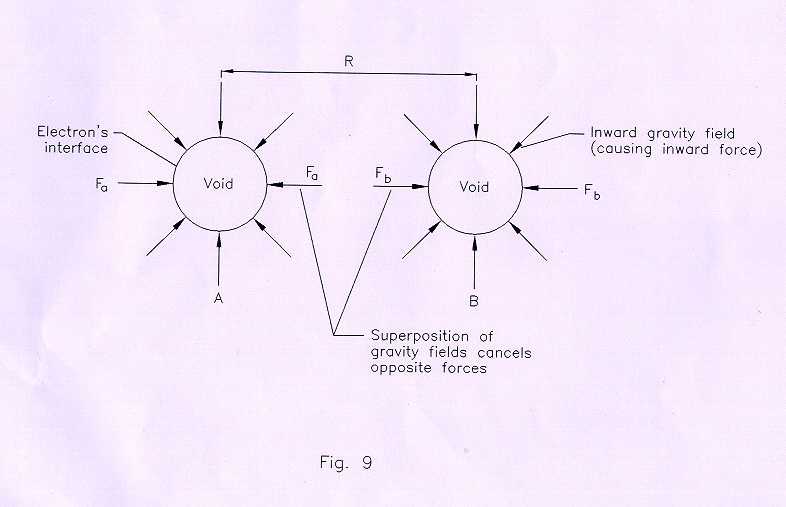
Therefore, the effect of light due to dying-gravitational-potential will have spherical symmetry. Whereas, the maximum electrostatic fields of these particles, is confined mostly to the diametrical plane at right angles to the axis of rotation (Fig.1); hence, maximum effect of light produced due to dying-electrostatic-potential will be confined within this plane.
Wavelength and Frequency
The wavelength of annihilation light (Fig.8) is equal
to the electron radius. This light, with a single shell, cannot have the
concept of frequency applicable to it. In case there are several annihilations
taking place at a point, one after the other, without absolutely any time
gap between the successive annihilations, then the frequency can be defined
as the nos. of shells formed in unit time. Also, if the time for the formation
of a single shell is D t, then frequency
f can be defined as: f = 1/D t, keeping in mind,
however, that this mathematical operation does not mean that the single
light-shell has the property of frequency as per the conventional definition
of frequency mentioned above. When light is produced due to atomic vibration
(Fig.10), the frequency of light is determined by the nos. of atomic oscillations
in unit time, assuming that the oscillations are continuous [2,3].
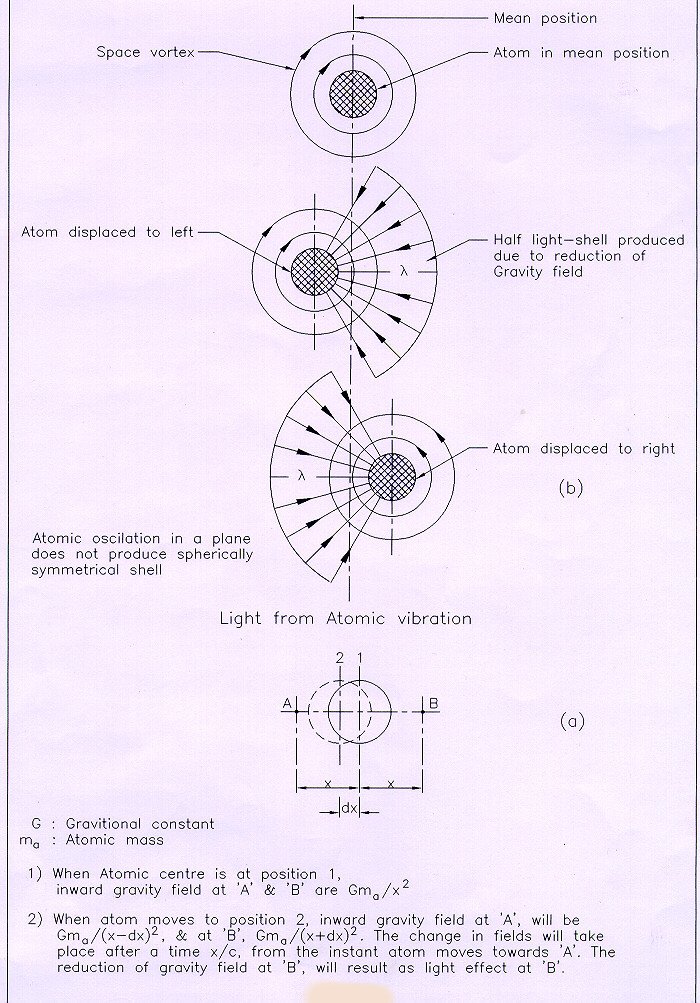
Fig. 10
The shell of light produced in annihilation, as well as a light -shell produced in atomic vibration have their centers fixed with the source (assumed stationary relative to space), while the wave front with a fixed wavelength (radial) is transmitted at speed c relative to space. In the modern concept of light, the photon, postulated as a "packet of energy", is understood to have its center moving at speed of light relative to the source. It is not clear as to how the concept of frequency is related with a photon; though, physical picture is not possible, perhaps, a photon wobbles transverse to its line of motion, a number of times say, f, in a unit time, while traversing at speed c relative to the source. And, if that is the possible physical picture, then, "f" will have meaning for a photon (with indivisible energy quantum, hf) only after it has traveled for a unit time having wobbled f times! Again, the specific characteristic of a photon that determines its wavelength remains obscure. Though, it is well known that the classical concepts of wavelength and frequency are inapplicable for a photon in quantum physics, in the absence of a physical picture, there occurs a serious conceptual error, leading to a mathematical discrepancy in the very basic relationship between energy and frequency in the Planck energy equation as pointed out below.
Planck Energy Equation
Based on the concepts of Maxwell-Hertz, that electromagnetic (light) energy is given off from electrical oscillators, Planck believed that the orbiting electrons inside the atoms of a glowing solid-emitter radiated electromagnetic waves in different quantities, the frequency being determined by the vibration of the oscillator. The classical picture was revised by Planck based on his observed experimental fact when he assumed that an oscillator, at any instant, could have its total energy (potential, kinetic) only as an integral multiple of the energy quantity hf, where h is a universal constant (experimentally determined) and f is the frequency of vibration of the oscillator. Thus, the light energy can be absorbed or emitted in an indivisible quantum of magnitude hf. Planck energy equation is:
E = h f. (8)
It can be also written as
E / f = h. (9)
It is seen from (9) that "h" is the energy associated with one oscillation of the vibrator, on the following basis.
It has been shown elsewhere [2,3] that a time varying gravitational potential at the surface of an atom produces light (Fig. 10); and that one shell of light produced due to atomic vibration has energy close to the experimentally determined value of h. Though Planck believed that the oscillator emits its own energy (kinetic, potential) possessed by it structurally, by deriving h from the varying gravitational potential in space external to the oscillating atom (Fig.10), a new fact has been brought to light: that the "least energy" produced (in each shell of light) is " E / f". Therefore, the quantity "h f" is, actually, the energy contained in f-numbers of successive light- shells produced by the oscillator in unit time, and cannot be an "indivisible quantum" of light-energy available at an instant, which Planck assumed.
Further, as stated earlier, the structures of the oscillators, either electrons or atoms, are not suited to absorb or emit energy-a serious misconception continuing since Maxwell's theoretical conclusion that oscillations of electric current leads to a loss of energy from the system in the form of electromagnetic waves. The modern concept that heat and light energy get detached from the oscillating atoms is corroborated in the following: "4…the collisions between atoms and molecules in a gas are said to be perfectly elastic. Although this is an excellent approximation, even such collisions are not perfectly elastic; otherwise one could not understand how energy in the form of light or heat radiation could come out of gas." But such a concept of energy absorption and emission is basically wrong with the vortex structure of electron and atom. Even in 'oscillating electric current', the electrons cannot part with their structural energy (the velocity field in the vortex).
The intrinsic angular momentum of electron derived from its vortex structure: L = (4/5) me c re; substituting the values of me and re, it is found [2,3] to be 7.5 times less than the Planck constant. However, for an average atom, Planck constant computed is close to the experimentally determined value [2,3].
The dimensions of h are that of angular momentum-same as the angular momentum of electron given above. Though, the angular momentum of electron is 7.5 times smaller than the accepted value of the Planck constant, the nearness of the two values may lead to a guess that the orbital electrons in the atoms are indeed the electric oscillators that produce light, as imagined by Planck and others, and as is also the prevalent concept. In this conjecture, however, following difficulty arises.
An atom shows overall electrical neutrality in the region beyond the orbital electrons, where only the gravitational field of the atom should exist. On account of this, h has been computed theoretically with the considerations of the time-varying potential of gravitation alone [2,3]. This is not to say that a charged atom will not produce light; rather the value of h obtained from an assembly of charged oscillating atoms should be different, and so also the nature of light (frequency, wavelength) produced.
Since the structure of light is shown to consist of successive shells, it can be said that light energy exists in quanta, where quanta is defined as "energy in each shell"; whereas, the kinetic energy of a moving body, which is proportional to the velocity of the body that can continuously vary, can not have quanta of energy. Any generalization coming out of Planck energy equation, and leading to the concept that all forms of energy occur in quanta, is therefore erroneous.
Black Body Radiation
In a hollow cavity, the equilibrium distribution of electromagnetic radiation energy, experimentally obtained, shows that at low frequency the energy is proportional to f2, while at high frequency there is an exponential drop. Whereas, the theoretical energy distribution as per Rayleigh-Jeans law gives excessive energy for higher frequency, such that if integrated over all frequencies the total energy becomes infinite. Though, classical mechanics places no limit to the frequency of the mechanical oscillators (atoms), a limit to the oscillator's frequency is imposed by the motion of the fluid-space submerging the atomic vortices (oscillators). The displacement of the atoms from their mean positions displaces space, which has a limiting speed c. If an average radius of atoms is taken as taken as 1.5 x 10-8cm, the displacement of an atom on either side of its mean position up to a length equal to the radius will involve total displacement relative to space as 3x10-8cm. Time required for the fluid space to move up to this length at its maximum speed is: 3x10-8cm/(3x1010cm/s) = 10-8s. The nos. of light shells produced in one second due to this atomic oscillation will be 1018/s, which is the frequency of the light produced. Thus, maximum frequency of the oscillators in thermal radiation, excluding X-rays and gamma, should be limited to about 1018/s. It can therefore be inferred that the exponential fall of energy distribution in cavity at higher frequencies is due to the reaction from space at higher oscillation frequencies. The classical concept that to determine the total energy within a cavity (black body radiation), integral has to extend over all the frequencies is based on a misconception that atoms oscillate in the void ness (reaction less) of space and hence there can be no limit to their frequency of oscillation.
Explaining Photoelectric Effect - Einstein's Error
In the vortex structure of atom (Fig.11), the vortices
of the orbital electrons, interlocked with the velocity fields of the atomic
vortex, are carried round the nucleus as explained earlier.
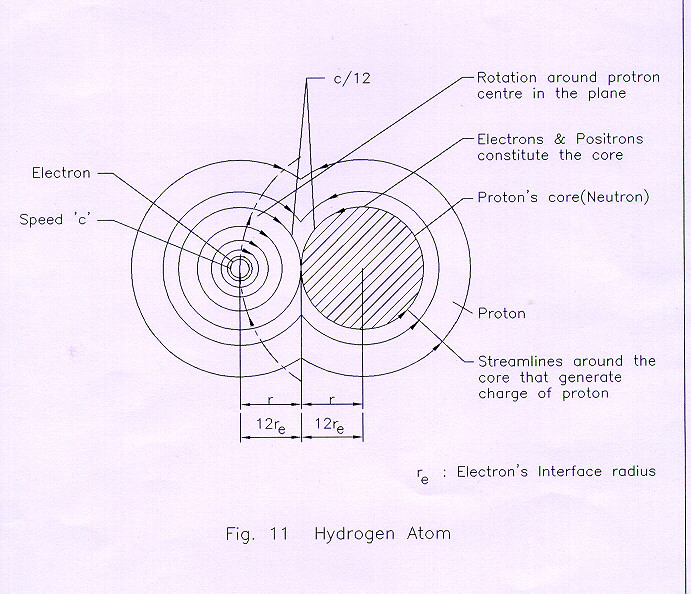
As is well known, the outer orbital electrons, if interacted with light of appropriate wavelength, are released in photoelectric effect. It is now believed that the photo- electrons absorb energy from the incident light for their release, and also for the kinetic energy that they possess. On this phenomenon, the following new aspects are to be taken into account.
As stated before, absorption of energy by an electron is, structurally, impossible. The orbital electron, already in circulating motion, possesses kinetic energy due to the velocity field of the atomic vortex. This energy is computed: The nuclear radius of an average atom is, rn = 2.37 x 10-9 cm. Like an electron, the nucleus too has its axis of rotation and, hence, the maximum electrostatic field is confined in a circular vortex in a plane (more or less), at right angles to the axis of rotation. In the irrotational vortex, space-circulation velocity falls inversely as the radius of rotation. In the electron vortex, in the diametrical plane transverse to the axis of rotation, c re = constant. Applying this relationship also on the nuclear surface,
c re = un rn (10)
where un is the maximum tangential velocity of space on the nuclear surface in the diametrical plane at right angles to the axis of rotation. Substituting in (10) the known values of c, re, and rn = 2.37 x 10-9 cm, we have
un = (3x1010) 4x10-11 / 2.37x10-9 = 5x108 cm/s. (11)
This velocity, as stated above, falls in the atomic vortex (around the nucleus) inversely as the radius of space rotation. Assuming the radius of rotation of the outermost orbital electron to be 10-8cm, the space circulation-speed, which is also the tangential-velocity of the orbital electron, will be
v = un (2.37x10-9cm) / 10-8cm =(5x108cm/s) 2.37x10-1 =1.2x108cm/s. (12)
The kinetic energy of the orbital electron is
E kin = (1/2) me v2 = (1/2) 10-27 (1.2x108) 2 = 7.2X10-12 erg. (13)
The experiments show that the kinetic energy of the photoelectrons is about 8x10-12 ergs, which is so very close to the value obtained above (13). It is thus seen that Einstein mistook the source of the kinetic energy of the photoelectron, thinking that it came from the incident light; whereas, the reality is that the velocity field in the atomic vortex projects the electron after the incident light has triggered its release, as explained below.
Production of light due to oscillation of an atom has been mentioned before (Fig.10). We shall analyze here the displacement of an atom during its oscillation, and the radial flow of the surrounding space. An atomic nucleus, composed of independent electronic voids, closely packed, approximates to a "spherical hole" in space, central with the atom. The atom, during displacement equal to its diameter, leaves a "hole" in its previous location. This "hole" is filled due to radial flow of space at speed c, through the light's first wavelength l , which gets formed. The time taken for this flow across the wavelength is l /c; and the acceleration of space is c / (l /c), which is c2/ l . Each successive wavelength, formed due to the oscillations of the atom, possesses the above inward acceleration-field across it (radial). Now suppose that the spherical wave front of one of these shells, during its transmission, meets an orbital electron of an atom. The orbital velocity v of this electron, is derived from the atomic vortex which subjects it to an inward acceleration v2 / r, where r is the radius of its rotation. The electron is held by electrical force, created by the above inward acceleration towards the nuclear center. The acceleration field c2/l , within the wavelength of the light shell that meets the orbital electron of the atom, is also inward, that is, towards the light source. For the electron to be released from the atomic vortex, the above two acceleration fields must be equal and opposite. Thus,
c2 / l = v2 / r (14)
Or l = c2 r / v2. (15)
Substituting the values: v = 1.2 x 10 8 cm/s obtained above (12); r = 10-8 cm; c = 3x1010 cm, the value of l comes to, 6.25x10-4 cm, which corresponds to the cutoff frequency of, 3 x 1010 / 6.25x10-4, that is, 0.48 x 1014 cycles/s. (For metallic sodium, the threshold frequency is about 5x1014 sec-1). Considering the approximate nature of the assumptions on the orbital radius of electron, and the radius of an average size of nucleus, with which the space-circulation velocity around the nucleus and the orbital velocity of the electron were calculated; any better result from (15) to conform to the experimentally obtained value of threshold frequency is unlikely. For, the orbital radius of the electron, if supposed to be 10-9cm, rather than 10-8cm, the thresh hold frequency calculated from (15) will be closer to the experimental value.
The additional information given by (15) is as follows. In atomic vortex, the velocity field falls inversely from the nucleus center; and therefore, the inner orbital electrons will have higher speed of rotation. On release by the incident light shell, these electrons will possess higher kinetic energy. It is seen from (15) that for higher value of the electron's speed v, the wavelength l is smaller. It is thus concluded that with higher frequency of the incident light, the photoelectrons released will show higher kinetic energy. This is an experimentally observed fact.
The above analysis shows that the concept of the photon-nature of light, with an indivisible quanta of energy possessed by each photon, is a case of the most serious misconception, which led Einstein (who was a believer in the emptiness of space, as evident from the formulation of special theory of relativity) to wrongly treat light-energy, hf, as the instantaneous value (when in reality, this energy is produced and accumulated in unit time); because this way, the kinetic energy of the photoelectrons, as observed experimentally, could be explained without going deeper into the structure of the atom (that became known later about 1912 through Rutherford's experiments) to determine whether the photoelectrons have any other source in the atomic structure that imparts kinetic energy to them at the time of their ejection from the atoms.
Though, Planck integrated together the energy of f nos. of shells erroneously, he still believed that light energy is distributed uniformly over an expanding set of wave fronts. In contrast, Einstein conceptualized that the energy of light is not distributed evenly over the whole wave front, as the classical picture demanded; rather it is concentrated or localized in discrete small regions. With the help of both these energy integration and concentration operations, the right order of magnitude of the kinetic energy of the photoelectrons, as observed experimentally, could be achieved at an instant in the quantity hf .
For better understanding of the physical significance of the "indivisible quanta", we take the following example: Consider the case of a light source producing successive spherical wave pulses or spherical shells of light with frequency f, say 1015/s and wavelength 3x10-5cm. In one second, the energy produced by f nos. of shells will be hf, that is 6.62x10-27 erg s x 1015/s = 6.62x10-12erg. Now, if it is desired to make the energy "hf" indivisible, then the independent shells produced successively in one second become indistinguishable, and the new imaginary wavelength of this light will become: l f = (3x10-5) cm x 1015 = 3x1010cm; while the frequency will be one, that is, only one wavelength of this large width of 3x1010cm will be produced in one second. The quantum physics will accept the energy of this new shell of light as calculated above, but not the new wavelength and frequency. It will accept the energy content of this new shell of light for explaining the photoelectric effect; and will reject the wavelength and frequency because the hidden inconsistencies in the photon model will come to the fore.
Without any physical picture, clarity and meaningful explanations, some of these ambiguous conceptions on the fundamental nature of light laid foundation to quantum physics.
Shortest Wavelength of Light
As is known, in positronium, the electron and positron circle each other, till annihilation; this happens due to interaction of their vortices. At the final instant preceding annihilation, the rotation of the particles will reach the limiting speed c, because this is the speed that space has on the interfaces of the particles. In (15) the value of v will be equal to c. Also the distance between the centers of the particles being 2re, the value of r in (15) will be 2re. Substituting these values in (15), the shortest possible wavelength of light is
l s = c2 (2re) / c2 = 2 re = 2 (4 x 10-11 cm)= 8 x 10-11 cm. (16)
The shortest wavelength of light in the universe is produced consequent to the annihilation of electron and positron.
Interaction of X-rays with Atoms
High-speed electrons, projected inside a vacuum tube and stopped by its walls produce X-rays. Here, each electron on impact and almost instantaneous-rebound leaves a "spherical hole" of the size of electron-void at the point of its contact with the wall, to be filled in with the space flowing nearly at speed c. This process is somewhat similar to the light produced during annihilation because, here too, the potentials in space associated with the electron at the instant of impact, die away, producing (which is seen as) X-rays. From each point of electron's contact with the wall, a spherical shell of light expanding at speed c will arise. Though the energy distribution on the wave front of the shell will fall inversely as the square of the radius of the expanding shell; yet, this shell after transmitting for some distance and with depleted energy-density on its wave front, on meeting an atom of a metal, releases an electron possessing kinetic energy almost equal to the kinetic energy of the first electron that produced the X-ray pulse. Indeed, the principle of energy conservation cannot explain this phenomenon because the same is not relevant here. Recognizing that light has the nature of successive shells, and in each shell, across the wavelength, exists an "acceleration field" of constant magnitude independent of the energy density in the wave front; the release of the electron, as discussed earlier in the case of the photoelectric effect, is attributable to this acceleration field, rather than to the energy density in the X-ray's wave front. If however, the explanation is sought with the idea of energy exchange between the X-ray and the ejected electron, this effect is most puzzling. In the words of Sir William Bragg: 'It is as if one dropped a plank into the sea from a height of 100 feet, and found that the spreading ripple was able, after traveling 1000 miles and becoming infinitesimal in comparison with the original amount, to act upon a wooden ship in such a way that a plank of that ship flew out of its place to a height of 100 feet.' Yet this effect was not utilized to support the wave nature of light. It was argued that the X-rays when passed through a gas, ionize only few molecules, and had the rays had the wave-property many more molecules should be ionized since the wave will meet all the molecules. This argument does not hold good with the shell nature of light; because, the acceleration-field in the X-ray shell has to be in opposition to the acceleration field of the orbital electron, that is, both the opposing acceleration fields must be in line for effective nullification of the electron's bond in the atomic vortex; which requires that the orbital electron, at the instant when it meets the light-shell (wave front), should be moving tangential to it. Obviously, such a disposition of the light shell and the electron can be only in rare encounters and, hence, the numbers of the ionized molecules with one shell of light are expected to be limited. Thus it is seen that wave nature (or more precisely shell nature) of light can explain the ionization of gases by the X-rays satisfactorily.
Bohr's Theory of Atomic Radiation
As per classical electromagnetism, electric charges in acceleration will radiate energy, and hence the orbital electrons in the atom will lose energy due to which the emitted radiation should continuously change. However, the existence of sharp spectrum lines, are not in accord with the above prediction of the classical theory. As a solution to this problem, Bohr postulated different 'energy states' for an atom, such that when it falls from a higher to the lower energy state, it emits a photon with energy hf as per Planck's energy equation.
As discussed before, in the space vortex structure of the atom and electron, the orbital electrons have already their fixed orbits. These electrons, carried by the vortex around the nucleus, can neither lose any energy (structural, potential or kinetic) due to orbital motion, nor change their orbits due to strong bond created by the velocity fields in between the nucleus and the electrons; because 'losing energy' by an electron signifies 'losing part of its vortex structure'. Further, these electrons make negligible contribution to the gravitational potential of the atom that, as seen before, produces light due to its time variation [2,3]. Moreover, the basic error of Bohr lies in the application of the concept of Planck's indivisible energy quanta hf, in equating the same with the differential energy between the two energy states, composed of the sum of the kinetic energy of the orbital electron and the electrical potential energy of the proton-electron system; this is because, as mentioned before, the energy 'hf' is the quantity produced in a unit time, whereas, the energy released due to difference between two energy states of Bohr (even if the energy states are supposed to exist) is instantaneous.
The Compton Effect
Compton's experiments are said to confirm that photon is a concentrated bundle of energy. The experiment consisted of a beam of X-rays of known wavelength falling on graphite block. He measured the intensity of the scattered X-rays with respect to their wavelength. His conclusion is that the X-rays are not waves but several photons each with energy, "h f". A photon, in his experiment, collides with a "free" electron in the graphite block, like the collision of billiard balls. He treats in his mathematical analysis the "free electron" as the one, which is not bound with the atom of the graphite block, and is at rest. The collision of photon, assumed with a free electron, has the following implication.
As is well known, X-rays can damage molecules and ionize gases; and like in photoelectric effect, will extract electrons bound in atoms. In the latter case, even if the outermost orbital electron is released, its own kinetic energy in the atomic vortex, as discussed before, will be about 10-11erg. By assuming the collision of the X-ray with a "stationary" electron, the initial kinetic energy of the electron prior to its release from the atom has been neglected. In any case, one cannot assume that the X-ray interacts only with a "free and motionless" electron. This kinetic energy of about 10-11erg will be larger for the inner orbital electrons, which rotate at greater speed. For, an inner orbital electron, with an average speed of three times the speed of the outermost electron, will increase the above kinetic energy to about 10-10erg. The quantity of energy, accounted in Compton's experiment against the kinetic energy of the recoil electron, is about the same order of magnitude; the concept behind is that the electron's recoil energy comes from the energy of the incident X-ray photon. If an X-ray of frequency 1017 is used during the experiment, its energy as per Planck energy equation will be; hf = 6.6x10-27x 1017 = 6.62x 10-10erg, which is not far from the above figure of the kinetic energy of the ejected electron that it would have had in the vortex of the atom due to its rotation prior to the release. On account of neglecting the initial kinetic energy of the released electron, and matching this figure with the indivisible energy quanta, Compton's conclusions on the photon nature of X-rays become erroneous. The misinterpretation of Compton experiment - that X-rays is not of wave but photon-nature - led to a misleading picture of photon, both qualitatively and quantitatively.
Another misconception in the above experiment is to believe that a bullet-like photon after striking an electron rebounds with a reduced frequency. Evidently Compton believed that a single photon has a frequency; that it oscillates, perhaps, across its line of motion. As stated earlier, frequency for light would be meaningful only if it is defined as the numbers of waves, photons or shells, produced per unit time. But, in case of a single photon, its wavelength is not known in a physical way except for the mathematical expression c / f, which leads to an imaginary large wavelength of 3 x1010cm, and a single frequency, described earlier. Compton's interpretation of his experiment together with the basic concept of relativity that all kinds of energy should have mass, made photon to possess hypothetical mass, momentum and inertia, while the most fundamental cause for its observed uniform motion at the constant speed of light remained unknown.
From the relevant literature, it is seen that Compton's arguments to assign momentum to a photon run as follows: As per the classical wave theory of light, if a body fully absorbs the energy E from a parallel beam of light, then a linear momentum E/c is transferred to the body. Based on this Compton, using Planck Energy equation E= h f, derives momentum, p, for an individual photon
p = E / c = h f / c = h / l . (17)
But the "radiation pressure" on a body is otherwise explainable by the interaction of light shell with the gravity field of atom without absorption of light energy [4]. The classical physics is equally wrong in the concept of absorption and emission of light energy. Further, the use of Planck Energy equation makes a single photon to possess enormous energy, that is, 1016 times the actual energy, if we use light of frequency 1016/s, because in reality, the energy of a single shell of light is, 6.62x10-27erg, as determined by Planck Constant.
It is seen that the concept of "energy quanta" misguided Compton too (after Einstein and Bohr) in the interpretation of his experimental results.
Constancy of the Speed of Light in Special Theory of Relativity
Einstein postulated that different observers, moving at uniform velocities relative to each other and to a source of light, should find their measurements of the speed of light to be the same, provided they use a defined reflection procedure. Let us suppose that light consists of several particles of energy (energy-as conventionally interpreted today, such that there is little difference at quantum level between matter and energy) say, electrons with properties of mass and momentum, being projected from a light source at random in all directions so as to form a uniform spherical distribution. The observers can choose any one of these particles for the test. A particular observer, moving in the same direction as his chosen particle, will find its speed different from the measurement of the other observer who is moving against the motion of the particle, as per classical relativity. Similarly, if light is imagined as a swarm of photons, each with mass, momentum and kinetic energy (as believed to day), being emitted from the source at random without any constant interval between the two successive photons from the same atom, the Galilean relativity will indeed be applicable, similar to the above-cited example of the shower of electrons; and the two observers will measure different velocity for the same photon. But, as shown before, the structure of light is that of successive shells of mass-less energy with a constant time-interval between the fronts of the adjoining shells emitted from each atom, as determined by the atom's vibration. It's the time-interval of emission between the successive shells that determines the frequency of light; whereas, in the earlier example of the photon-model of light, the frequency of light is a mere mathematical quantity, E/h, having no relationship with the timings of emission of the two successive photons from the same atom. It is this haziness on the physical picture of the frequency and wavelength of a photon that leads to misinterpretations of the results of several experiments devised to check the above postulate of special relativity. The following simple analysis, almost trivial, supports constancy of light-speed measurements by different observers in relative uniform motion postulated by Einstein.
In Fig.12 a source of light S (stationary with respect
to space) from which a single spherical shell of light, produced consequent
to the annihilation of an electron and a positron located in S, is transmitted
at a constant speed c relative to the medium of space.

When the wave front of this shell meets the eye of an observer O, who is also stationary relative to the static space, let him record this instant assuming that his time is the same as that of any other observer (universal time) who may even be in motion relative to space. Let him also record the instant when the tail end of the shell passes away from him. If l is the radial width of this light-shell (wave length of this shell of light is re, equal to the electron radius), then, from the ratio of l and the time difference between the above two instants, say t1, the observer can calculate the speed of light from the relation
c = l (1/ t1) = l / t1 (18)
because, light-effect is postulated to be transmitted within the wavelength at constant speed c relative to the stationary space. Let S produce similar shells in succession such that the tail end of a shell coincides with the front of the following shell. If the nos. of shells received by O in unit time is f, he will calculate the distance covered by f nos. of shells in unit time as fl , and time duration as ft1. With the ratio of these two quantities he will get the value of c, same as before. It is seen that the measurement of the light velocity across one wavelength is the same as across any of the successive wavelengths, provided the successive shells are similar with no interruptions in between. Now let O move with a uniform velocity v relative to the static space towards S, and record his timings across one shell. Because his velocity relative to the light shell now is v + c, time elapsed across one shell will be
t2 = l / (c + v) (19)
which is shorter than t1 measured earlier. The moving observer's eye interacts with the light-effect within the approaching shell for a shorter duration now and, hence, he sees the wavelength as:
l m = length through which the light effect is transmitted in time t2
= c t2 = c l / (c + v). (20)
The nos. of shells meeting the eye of the observer in unit time from (19) will be
fm = 1 / t2 = 1 / [l / (c + v)] = (c + v) / l . (21)
The moving observer can now determine the light speed from (20) and (21) as:
Speed of light = l m fm = [c l / (c + v)] (c + v) / l = c. (22)
From (18) and (22) it is seen that the observer, in moving as well as stationary states, finds that the speed of light is constant; and he reaches this conclusion without sacrificing the traditional concept of time.
In the well-known experiment of Sagnac, a beam of light is split into two halves that travel around closed identical paths (reflected through mirrors) in opposite directions, and combined again in a detector to examine their interference pattern. The rotation of the apparatus produces shift in interference fringes as a function of the angular velocity. From (20) and (21) the reflecting mirrors along one path, rotating opposite to the light beam, will 'see' shorter wavelength and, proportionately, more of light-shells in unit time (frequency); while the mirrors rotating in the same direction as the light beam in the other path, will see longer wavelength and lesser nos. of the light-shells in the same time interval. On account of this, the wavelength as well as the frequency of the two beams reaching the detector will be different and, consequently, a shift in the interference fringes will occur. The product of the wavelength and the corresponding frequency for each path of the beam remaining the same, the mirrors placed in the two paths (observers) will find the same value of the velocity of light. Therefore, on rotation of the apparatus, appearance of the shift in the interference fringes in Sagnac's experiment should not be taken to mean that the light has different speeds (relative to space) along the two paths.
The above interpretation of Sagnac experiment can be confirmed by increasing the nos. of the reflecting mirrors in each path; in which case the shift in the interference pattern should increase.
The effect of light at a space point involves creation of light shell there from the already existing gravitational potential at that point, and its further transmission. This process repeats continuously as the light shell traverses each point in space. In the various experiments, set up to determine the light speed, only transmission aspect of light is taken into account, neglecting the process of the formation of the wavelength-the radial spread of light. That is why a "ray" of light, supposed to be continuously issuing forth from the source, is erroneously supposed to have instantaneous reflection from a mirror, and also instantaneous interaction with the eye of the observer; as if the wavelength is zero. Due to this misconception, it does not become apparent that a moving mirror reflects light of wavelength different from what it receives; and a moving observer too sees light of wavelength different from what he sees the same light to be, when stationary relative to space.
Considering Einstein's treatment of special relativity, in the moving frame of reference (with respect to the stationary one) the reflecting mirror for the light signal located at the X- axis, should also be moving at uniform velocity like the observer; the ray of light (replaced by annihilation light source, sending out light-shells one after the other) from the origin of the axes towards the +X axis in this frame of reference will be reflected by the moving mirror at an increased wavelength and decreased frequency, as shown above; and the observer, because of his motion opposite to the reflected ray, will find the wavelength of this light decreased and the frequency increased proportionately. In the stationary frame of reference, the stationary observer receives the reflected ray of the same wavelength as that of the ongoing ray. Thus, the observers in both the reference frames find the reflected ray having the same wavelength. Since their time is the same as the universal time, the nos. of shells per unit time, that is the frequency of the light ray, will be equal for both of them; hence, they get the same velocity of light irrespective of the motion of the moving observer.
Fresenel, around 1820, postulated ether-drag in a moving material medium and increase in light velocity on account of this. His ether-drag is close to the velocity-field that gets associated with the moving molecules of matter-responsible for momentum [2,3]. Transmission of light along the motion of the medium will increase the wavelength, whereas, it's opposite direction will decrease it. As the respective frequencies also will proportionality change, the velocity of light in both the directions of light will remain the same. This subtle aspect, that despite changes in wavelengths the speed of light will be the same, had not been taken note of. Fizeau's experiment to measure speed of light in flowing water detected changes in speed because he based his conclusion on fringe-shift that will occur when unequal wavelengths are superposed.
In the assumed void-ness in space of 20th century physics, which provides no explanation to the creation of matter and fields, speed of light too has no medium, either for its creation or for transmission; in fact in a medium of nothing ness, matter and light cannot exist. Therefore, if the velocity of light measured by different observers in uniform relative motion with respect to each other has to be the same as postulated in special theory of relativity, the spatial-reality and shell-nature of light require recognition. With this proposed conceptual shift on the basic nature of the absolute vacuum and the nature of light, the relativistic concepts involving changes in length and time dependent on the motion of the observers will become redundant.
Light speed is Independent of the Motion of the Source
Consider an electron with its vortex structure. At any point in space, the velocity field and its radial distance from the vortex center will determine the magnitudes of its gravitational and electrostatic potentials [1,2.3]. As discussed earlier, a displacement of the electron's center will produce changes in the potentials; such changes will occur during electron's motion, either uniform are accelerating. The equalization of potentials due to self-action of space takes place at speed c with respect to space. Therefore, considering motion of electron at ordinary velocity, it can be assumed that the field structure of electron retains its original symmetry of distribution as before in static state.
Let an electron and a positron, moving together at ordinary speed, under go annihilation. After collapse of the electron-void during annihilation, it loses mass, charge, and its existence; but, since the entire field distribution can not die instantly, the light shell produced continues its transmission relative to space with the point of annihilation as its center, independent of the speed of the particles prior to the instant of their annihilation. The point of annihilation and the surrounding field structure get fixed relative to space subsequent to the annihilation. On similar arguments it will be seen that light produced during atomic vibration is transmitted at speed c relative to space due to self-action of space to equalize the potential gradients. Further, since light shells are mass less entities, not emitted from within the electron or atom in the light source, they cannot carry the momentum of the source (light-producing particles, atoms and electrons in the constitution of the moving source of light).
Time Dilation
The traditional concept of time was revised in special relativity. Though it has been shown above that with the shell-nature of light, the postulate of relativity on invariance of the speed of light in different frames of reference is supported, the following thought experiment reveals the fallacy of the often-quoted arguments5 in support of time dilation.
Fig.13 shows a platform in uniform motion with two observers
A and B on it, and another stationary observer C on the ground.
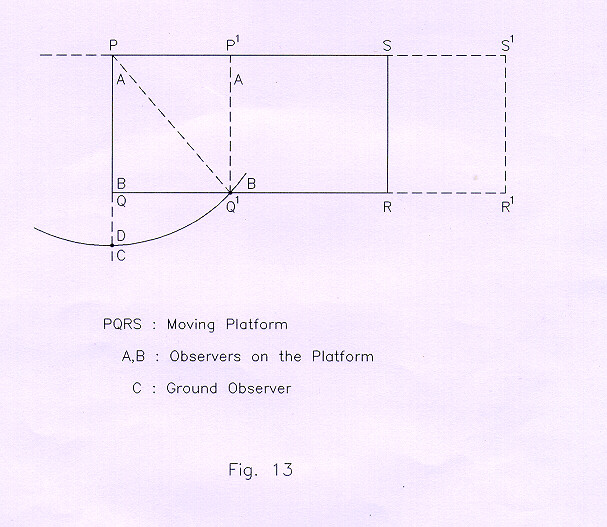
The relativist's view is that 'if the observer A lights a match-stick creating a flash, the observer B sitting opposite to him will think that the flash has directly come to him along the route PQ, whereas, the observer C will see the path along PQ1, since, during the time the flash has reached him, the platform has reached to a new location P1 Q1 R1 S1. The path of the flash does not look the same to the two observers B and C. Since the flash is moving with A, it seems to B taking a longer path; and if the speed of light is to remain the same, the longer path must seem to take longer time: time must pass faster for C'. The misconception on the nature of light in the above statement is the presupposition that "the flash is moving with A". But is the flash really moving with the observer A? It has been shown above that the speed of light is independent of the motion of the source. Hence, the uniform motion of A cannot be imparted to the flash of light that he creates by striking a match. To further pinpoint the relativistic misconception on the motion of the flash along with A, let us suppose that A has with him an electron and a positron that undergo at some instant annihilation. As explained in the earlier section, the point of annihilation along with the field structure of the particles will get fixed in space, while the observers A and B will move on. Supposing, B can see the point of annihilation P even prior to the instant when the light shell consequent to annihilation reaches him, he will see that P is shifting to his left due to his own motion (relative to space) to the right along with the platform; and by the time B reaches Q1, he will see that the light shell has taken the route PQ1 to reach him; PQ1 is the same length as seen by C. Therefore, the assumption of the relativist that the flash of light is moving with A is erroneous. Further, if the stationary observer C stands at D, where PQ1 = PD, the light shell will reach both B and C at the same instant.
It has been shown that the new concepts of 'time dilation' and 'simultaneity' are clearly superfluous in special theory of relativity, since, the invariance of the speed of light in different frames of reference in relative uniform motion follows otherwise from its very basic nature.
Conclusion
The ether was declared superfluous in special relativity
without identifying and providing a substitute for a universal entity,
which could create cosmic energy and matter. And in the absence of a basic
theory of matter that alone can reveal the genesis of material properties
(mass, inertia, charge), and the associated energy-fields including electromagnetic,
any generalization that the laws of nature are invariant in respect of
all inertial systems will certainly lead to a highly complex theorization,
just as special relativity has come to be. But, despite that, discarding
photon model of light, and with a nonmaterial fluid space, Einstein's Light-Principle-that
the velocity of light is invariant in respect of all inertial system, is
vindicated with the shell-nature of light, which light in reality is.
Notes
* Former Executive Director (Nuclear Projects), Nuclear Power Corporation, India.
1 It has been shown that Planck constant is not a universal constant; and, theoretically, each atom has a Planck constant with slight difference in magnitude. Electron too has a Planck constant.
2 Creation of electrons and positrons take place in the interiors of the stars and the galactic center, where space circulations reach the limiting speed.
3 The word "pressure" is used in material fluid; for fluid-space another appropriate word is to be coined.
4 The Feynman Lectures on physics, Feynman,Leighton, Sands; Vol. 1, page 10-9.
5 "The Clock Paradox", Dr. J. Bronowski, Scientific
American, February 1963, Vol. 208, No.2. pp. 134-144.
References
1. P. Tewari, (1982), "Space is the Absolute Reality", Proceedings of ICSTA, International Publishers, East-West , Niederschocklstr, 62, 8044 Graz, Austria.
2. P. Tewari, (1995), Beyond Matter - A Comprehensive Theory of the Material Universe, Editor: Wolfram Bahmann, Feyermuhler Str, 12, D-53894 Mechernich.
3. P. Tewari, (1984, 1996), Beyond Matter, Crest Publishing House, G-2, Ansari Road, Darya Ganj, New Delhi - 110 002.
4. P.Tewari, (2000), "Conceptual Error on the Fundamental Nature of Light-Phenomenon in classical electrodynamics, led to the Complexities in Quantum Physics", Journal of New Energy, Vol.5, No. 1.3084 E.3300 South, Salt Lake City, Utah 84109-2154.
- - - - -
Paramahamsa Tewari was born on January 6, 1937, and graduated in Electrical Engineering in 1958 from Banaras Engineering College, India, and held responsible positions in large engineering construction organizations, mostly in Nuclear Projects of the Department of Atomic Energy, India. He was also deputed abroad for a year at Douglas Point Nuclear Project, Canada. He retired in 1997 from his position as Executive Nuclear Director, Nuclear Power Corporation, Department of Atomic Energy, India, and is the former Project Director of the Kaiga Atomic Power Project. Fundamentals of physics attracted Tewari's imaginations right from the early school and college days. Over the last two decades his new ideas on the basic nature of space, energy, and matter have concretized into definite shape from which a new theory (Space Vortex Theory) has emerged. The theory reveals the most basic issue of relationship between space and matter precisely pinpointing that space is a more fundamental entity than matter. The physical significance of mass, inertia, gravitation, charge and light are revealed by extending the analysis in the theory beyond material properties and into the substratum of space, which again is broken down into fieldless voids, thus showing the limit to which a physical theory can possibly reach. The real universe is shown to be opposite to the current concepts of concrete-matter and empty space. The books that he has authored on Space Vortex Theory are: The Substantial Space and Void Nature of Elementary Material Particles (1977); Space Vortices of Energy and Matter (1978); The Origin of Electron's Mass, Charge Gravitational and Electromagnetic Fields from "Empty Space" (1982); Beyond Matter (1984). He has lectured as invited speaker in international conferences in Germany, USA, and Italy on the newly discovered phenomenon of Space Power Generation. For the practical demonstration of generation of electrical power from the medium of space, Tewari has built Space Power Generators that operate at over-unity efficiency, thereby showing that space medium indeed is the source of generation of basic forms of energy.
http://www.tewari.org/
ptewari1@sancharnet.in
[See even the presentation of Dr. Tewari's book which
is published in the first Section of this same number of Episteme]